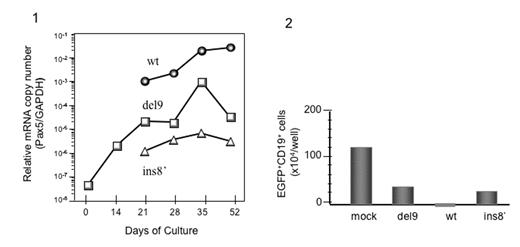Abstract
Pax5 is a key regulator of B cell commitment and is indispensable throughout the early stages of B cell differentiation. Human B lymphopoiesis can be simulated by cultivating cord blood (CB) progenitor cells on the murine bone marrow stromal cell line such as HESS-5. When CB CD34+ cells are seeded onto HESS-5 cells and supplemented with SCF and G-CSF, the number of non-adherent myeloid cells initially increases, reaching a maximum during the 3rd week, and decreases rapidly thereafter. On the other hand, foci of small B-lymphoid cells beneath the stromal layer appear during the 2nd week and increase in size until the 6th week. In this culture system, we have identified two C-terminal splice variants of Pax5; one skips exon 9 without subsequent frameshift (del9), and the other has a frameshift insert between exon 8 and 9, resulting in novel C-terminal sequences (ins8′). By quantitative RT-PCR analysis, del9 mRNA was barely detected in CB CD34+ cells and thereafter upregulated in progenitor B cells during the culture. In contrast, wild-type Pax5 (wt) and ins8′ mRNA could not be detected until the 3rd week. Then, wt mRNA was rapidly upregulated 100-fold or more abundantly than del9 and ins8′ mRNA (Fig. 1). Transactivation potential of Pax5 isoforms was examined with a reporter plasmid containing high-affinity Pax5 binding sites from the CD19 gene linked to the minimal TATA-like promoter. As a result, del9 showed constantly higher (up to 3.5-fold) activity, but ins8′ had slightly lower activity than wt Pax5. Furthermore, TLE4, a Groucho co-repressor family member and a known Pax5 partner, inhibited the transcriptional activity of wt Pax5 but not del9 or ins8′ isoform, suggesting its interaction with the exon 9 sequences of Pax5. We next examined the impact of Pax5 on growth and differentiation of CB CD34+ cells by retroviral transduction of each isoform as well as EGFP. After infection, sorted EGFP + cells were subjected to the colony-forming assay and the co-culture assay on HESS-5 cells. Erythroid or mixed colony formation was almost completely inhibited by either isoform. GM-colony formation was moderately inhibited by del9 and ins8′ isoforms, but profoundly suppressed by wt Pax5. In coculture with HESS-5 cells, the number of non-adherent myeloid cells was reduced by Pax5 isoforms in a similar manner to the results of GM-colony formation. Unexpectedly, after 6 weeks of culture, the number of CD19+ adherent lymphoid cells decreased more profoundly in the culture transduced with wt Pax5 than those with del9 and ins8′ isoforms (Fig 2). These results suggest that constitutive expression of Pax5 in cord blood progenitor cells substantially inhibits not only myelopoiesis but also B lymphopoiesis through the exon 9-dependent and independent mechanism. We also raise the possibility that developmentally regulated concentration of Pax5 isoforms may be crucial for human B lymphopoiesis.
Author notes
Corresponding author


